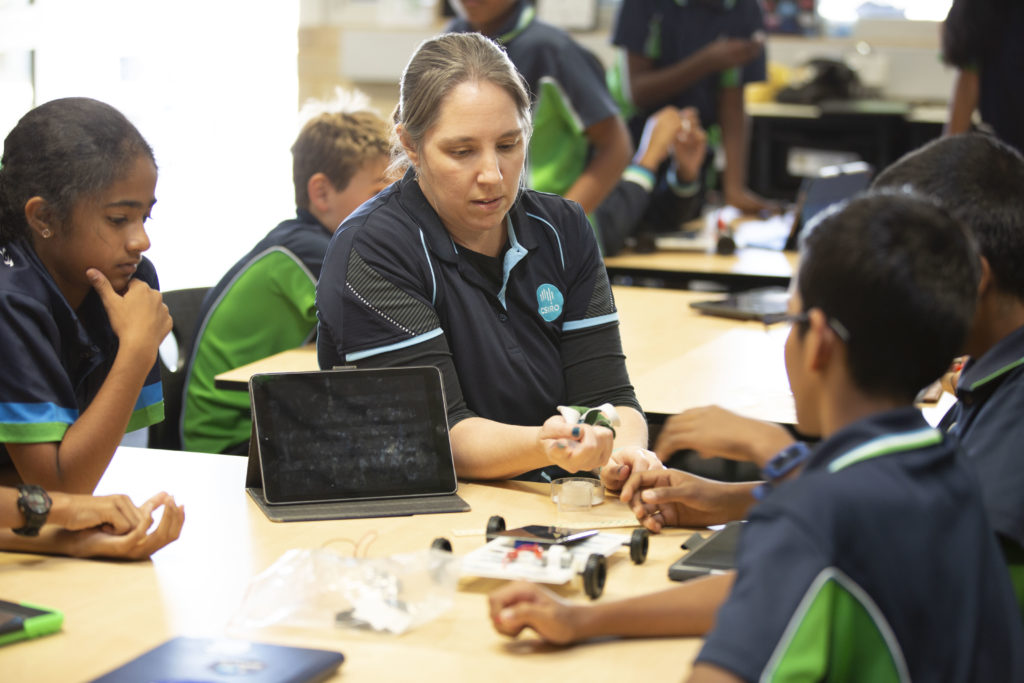
Dr Chenoa Tremblay explores many different STEM subjects when she visits students in schools.
Dr Chenoa Tremblay is an astronomer working at CSIRO as a Postdoctoral Fellow in dark magnetism. She uses supercomputers to analyse large radio astronomy datasets to improve our understanding of star and galaxy formation. Her research underpins the search for signs of life beyond our own here on Earth. She’s also a busy mum of a teenager, and in her spare time plays bass guitar and paints board game miniatures.
Chenoa manages to squeeze one more priority into her busy schedule: volunteering.
Chenoa is one of approximately 3000 volunteers who are part of STEM Professionals in Schools. This is Australia’s largest national skilled volunteering program for STEM professionals and classroom educators.
The program individually matches teachers and STEM professionals. They work together to increase teachers’ and students’ STEM skills, knowledge, and confidence through a range of activities. Each partnership is unique and flexible, as the partners decide what works best for them. Each partnership receives support from the national STEM Professionals in Schools team.
Chenoa has two partnerships, visiting a primary school twice a term, and a high school during Term 4 each year. Together with her partnered teachers, she has explored all manner of STEM subjects with the students. Some of the activities have related to Chenoa’s work like exploring how telescopes work. This gave students the opportunity to observe space objects through the SPIRIT telescope run by the University of Western Australia. Other activities with the students have covered broader topics. These include building items, like hydraulic robot arms, and making interactive windmills from recyclable materials. The students also made apparatuses to test the physics of how a paper butterfly flies using wind tunnels.
Why it matters
Chenoa begins each new year by introducing herself, her background, and how she got started in a career in science.
“I think it’s important to break down what makes a scientist, and who can be one,” Chenoa said.
“Growing up I had a notion of what being a scientist would involve, but had limited exposure to science or a role model. As a result, I initially pursued a degree in accounting because I was familiar with farming and small business.
“It wasn’t until I realised that I preferred to help my university roommate with her chemistry homework that I even entertained the thought of pursuing a career in STEM. The idea was daunting, but with some encouragement from some close friends and my boyfriend (now husband), I made the switch to chemistry, and a year later went on to complete a PhD in Physics. I’ve been on an incredible journey with it ever since, with many opportunities to travel and explore some of life’s biggest questions.”
Inviting students along for the journey
It’s a journey that Chenoa has invited the students to join her on. In 2020, a group of like-minded researchers from science and technology fields hosted an online symposium that we sponsored. It was called The Future of Meetings. The symposium explored what future conferences might look like based on the themes of inclusivity, accessibility, sustainability and technology. The students Chenoa works with at Harrisdale Primary School were invited to speak at the event. The students discussed the importance of sustainability when planning events in the future.
“Virtual meetings drastically reduce our carbon footprint on the planet, and the students delivered some very powerful statements to more than 1000 attendees of the symposium demonstrating their passion for taking climate change seriously,” Chenoa said.
“Our learnings from the symposium were published in Nature Astronomy. It was really special for the students to be a part of that.
“Science is about challenging our understanding of the world, galaxy and universe around us. It is a way of thinking that takes very large questions or problems and breaks them up into smaller pieces that we can solve before relating that back to the larger questions.
“With this approach there’s no reason why even young students can’t be involved in solving very big questions, and part of my purpose in volunteering is showing them that,” she said.

Dr Chenoa Tremblay undertook a solar car activity using the kits from the Synergy Solar Car Challenge.
Giving and receiving
Volunteering benefits both the teachers and STEM professionals involved too. Professionally, Chenoa says it inspires her on a regular basis.
“Working in academic settings, it’s so easy to get lost in our science, and to lose motivation with our work. I’ve found that working with students gives my energy and enthusiasm a boost. It’s as inspiring for me as it is for them,” Chenoa said.
“On a practical note, there is no better way to prepare for an interview or to practice talking to people with different levels of understanding of a topic than working with school students. It’s a very useful skill to have.
“Volunteering also gives me an opportunity to explore topics I might not have thought to explore on my own. For example, I hadn’t considered studying how a butterfly flies until the students asked to talk about zoology.
“As one of my partnered teachers once mentioned to her class: she doesn’t know everything, and I don’t know everything, but together we know more and can figure out the rest together,” she said.


6th May 2022 at 8:19 pm
So delighted to hear your story Dr Chenoa. It’s a great initiative to educate young people and to work towards shaping their career.
21st May 2021 at 9:50 pm
How wonderful to be able to relate one’s research to young people and inspire the next generation of scientists.